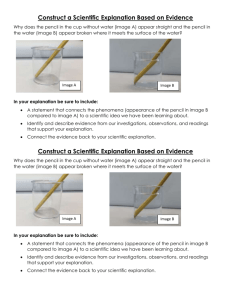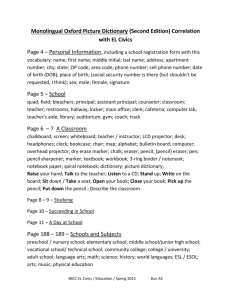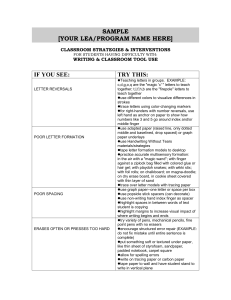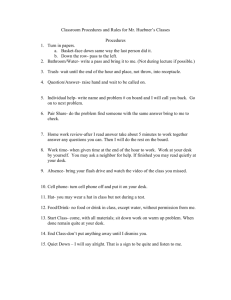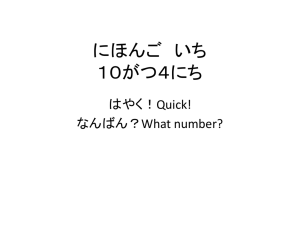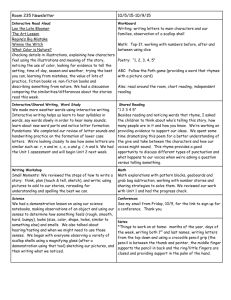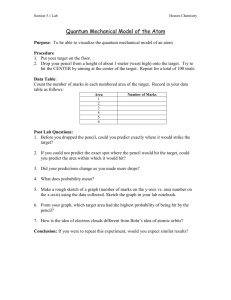Common Handwriting Problems and Solutions
advertisement
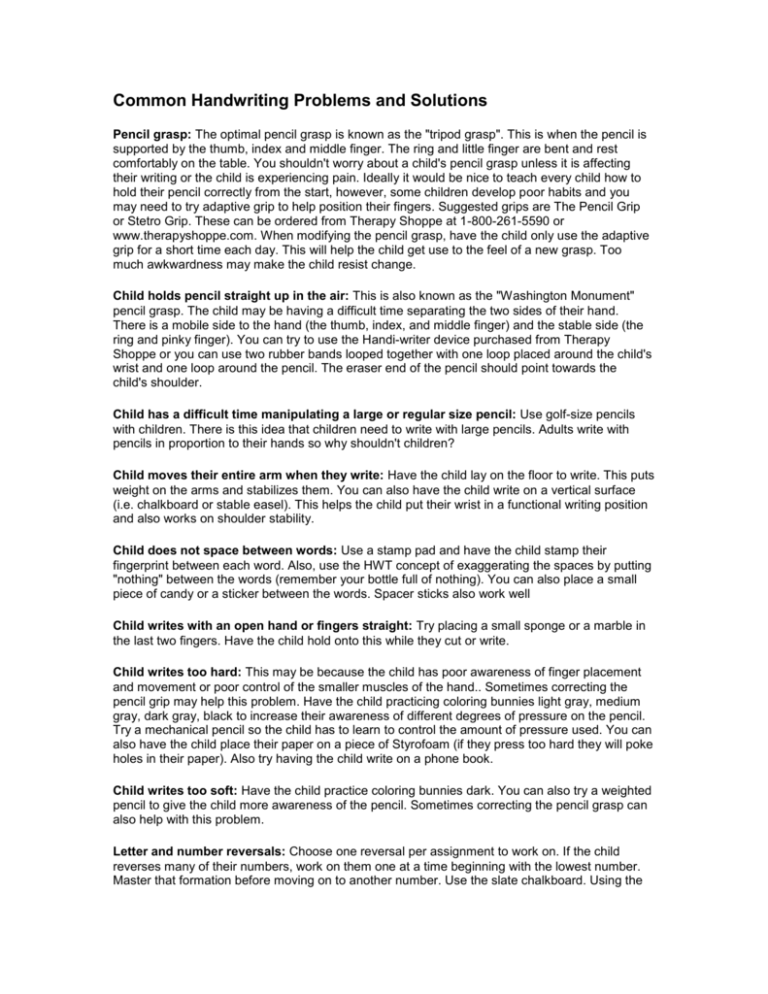
Common Handwriting Problems and Solutions Pencil grasp: The optimal pencil grasp is known as the "tripod grasp". This is when the pencil is supported by the thumb, index and middle finger. The ring and little finger are bent and rest comfortably on the table. You shouldn't worry about a child's pencil grasp unless it is affecting their writing or the child is experiencing pain. Ideally it would be nice to teach every child how to hold their pencil correctly from the start, however, some children develop poor habits and you may need to try adaptive grip to help position their fingers. Suggested grips are The Pencil Grip or Stetro Grip. These can be ordered from Therapy Shoppe at 1-800-261-5590 or www.therapyshoppe.com. When modifying the pencil grasp, have the child only use the adaptive grip for a short time each day. This will help the child get use to the feel of a new grasp. Too much awkwardness may make the child resist change. Child holds pencil straight up in the air: This is also known as the "Washington Monument" pencil grasp. The child may be having a difficult time separating the two sides of their hand. There is a mobile side to the hand (the thumb, index, and middle finger) and the stable side (the ring and pinky finger). You can try to use the Handi-writer device purchased from Therapy Shoppe or you can use two rubber bands looped together with one loop placed around the child's wrist and one loop around the pencil. The eraser end of the pencil should point towards the child's shoulder. Child has a difficult time manipulating a large or regular size pencil: Use golf-size pencils with children. There is this idea that children need to write with large pencils. Adults write with pencils in proportion to their hands so why shouldn't children? Child moves their entire arm when they write: Have the child lay on the floor to write. This puts weight on the arms and stabilizes them. You can also have the child write on a vertical surface (i.e. chalkboard or stable easel). This helps the child put their wrist in a functional writing position and also works on shoulder stability. Child does not space between words: Use a stamp pad and have the child stamp their fingerprint between each word. Also, use the HWT concept of exaggerating the spaces by putting "nothing" between the words (remember your bottle full of nothing). You can also place a small piece of candy or a sticker between the words. Spacer sticks also work well Child writes with an open hand or fingers straight: Try placing a small sponge or a marble in the last two fingers. Have the child hold onto this while they cut or write. Child writes too hard: This may be because the child has poor awareness of finger placement and movement or poor control of the smaller muscles of the hand.. Sometimes correcting the pencil grip may help this problem. Have the child practicing coloring bunnies light gray, medium gray, dark gray, black to increase their awareness of different degrees of pressure on the pencil. Try a mechanical pencil so the child has to learn to control the amount of pressure used. You can also have the child place their paper on a piece of Styrofoam (if they press too hard they will poke holes in their paper). Also try having the child write on a phone book. Child writes too soft: Have the child practice coloring bunnies dark. You can also try a weighted pencil to give the child more awareness of the pencil. Sometimes correcting the pencil grasp can also help with this problem. Letter and number reversals: Choose one reversal per assignment to work on. If the child reverses many of their numbers, work on them one at a time beginning with the lowest number. Master that formation before moving on to another number. Use the slate chalkboard. Using the "starting corner (smiley face)" the child will quickly learn to form the letter the right way. You demonstrate and the child imitates. Awkward letter formations: If the letter formations are "Magic C" letters, use the mystery letter game on page 20 of My Printing Book. You can photocopy this page for extra practice. For other letters you demonstrate the letters and have the child imitate you. Poor posture: Children will sacrifice all forms of mobility for stability. Children need to sit in their chair with their hips, knees and feet at a 90-degree angle. If the child's feet do not touch the floor try placing a box or stool under their feet to help with stability. Old fashion desks are great for proper positioning for writing. If your children sit at tables you may need to adjust the height of the table or chair to get an optimal position. Remember to have the children "Stack Their Blocks" and play the "Stomping Game". This wakes the children up and gets them ready to write. These exercises are found on page 11 and 12 of the green Handwriting Without Tears book. Child wraps their thumb around the pencil: Try using the Thumb Buddy . This was invented by Jan Z. Olsen and can be purchased at the Therapy Shoppe at 1-800-261-5590 or www.therapyshoppe.com. It works very well with children who have stability problems. It requires adult help to put it on. Poor paper placement: Beginners (learning to print letters and words) can place the paper straight (not tilted). Experienced printers (able to print sentences across the page) should place the paper at a slight angle to follow the natural arc of the writing hand. The angle or tilt should follow the natural arc of the writing hand. See the illustration found on Printing Teacher's Guide page 11, but this is easy to remember. For right-handed children, put the right(top right corner shown in illus.) corner higher; for left-handed, the left corner (shown) is higher. The writing hand is below the line of writing. This encourages the correct neutral wrist position. Child doesn't stabilize paper with other hand: If the child is disabled use a clipboard or a piece of tape to hold their paper in place. For other children try naming their helper hand (non-dominant hand) and show it how it has other jobs to do. Children love when you talk to their hand like it is a person. Child has a difficult time seeing the blackboard: Child may need an eye exam to rule out the need for glasses. Also children at this age may have a difficult time looking up to a vertical surface and then back down to a horizontal surface. Maybe try having the child work on a vertical/slanted surface. If a slanted desk is not available you can try a slant board (talk to your OT about getting one of these) or adapt a three-ring binder for children to work on. Child holds pencil too close or too far from the tip: Wrap a small rubber band around the area where the fingers should be placed. This will remind the child where to hold the pencil. When using a traditional pencil, remind them to hold the pencil "where the paint ends."
